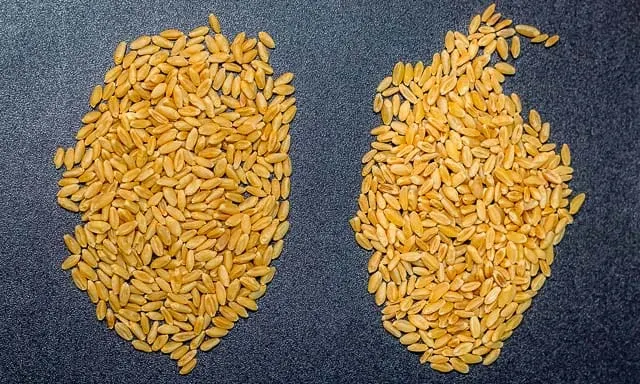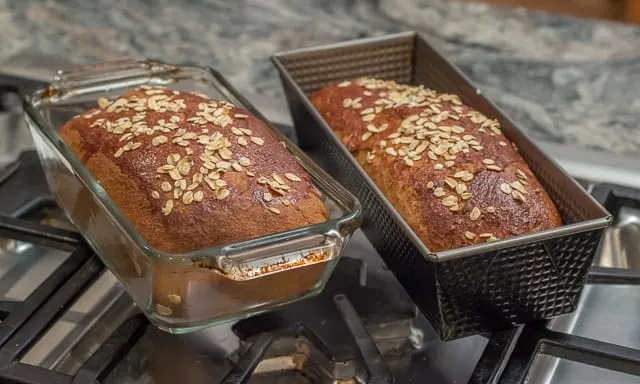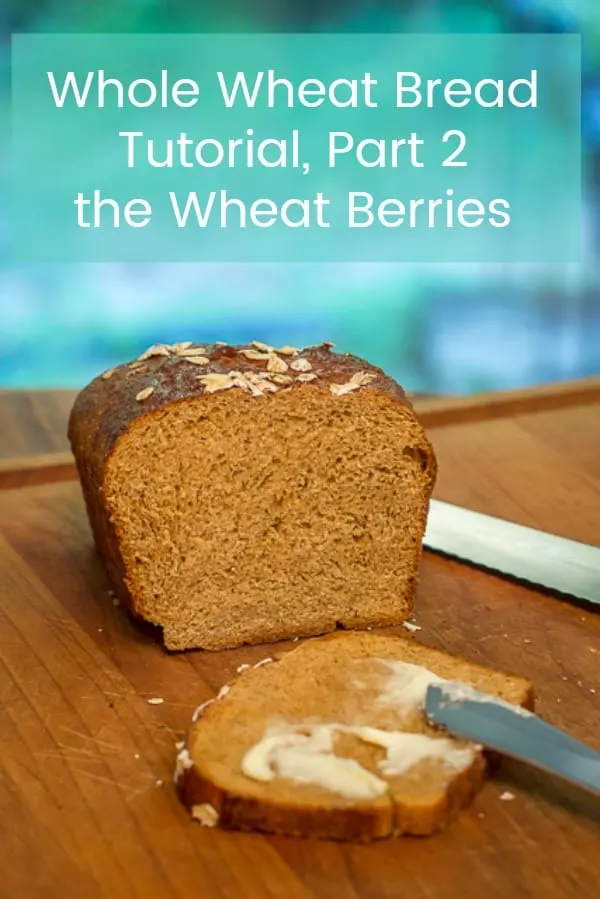This post contains links that, if you click on them and make a purchase, will earn me money. As an Amazon Associate, I earn from qualifying purchases. . Regardless, I only recommend products or services that I believe will be good for my readers. Thanks for helping me continue to produce great content!
This post contains affiliate links. That means if you buy something because you clicked on a link in this post, I might earn enough to buy a hot fudge sundae. I promise to share it with my family.
If you’re going to make delicious homemade whole wheat bread, from flour you’ve ground yourself, you’re going to need wheat berries! That’s actually a task that is easier said, than done.
By the way, this post is part 2 in a series of posts I am sharing, that give the basics of making homemade whole wheat bread. Part 1 can be found here. (In Part 1, I tell you why I decided to grind my own flour, and there’s a terrific deal for you on a NutriMill Grain Mill, if you use my special code.)
Just so you know: it is killing me to write this post this morning.
Why?
I’m out of bread.
And there is nothing more delicious for breakfast than a slice of this bread, buttered, fried in a frying pan, with a sunny side up egg gently sputtering beside it, and then slid ceremoniously onto that toasty slice of slightly sweet and nutty homemade whole wheat bread.
The fact that I’m presently out of homemade whole wheat bread is one of those little ironies in life that are sometimes the most delicious. Or, the most tortuous. But right now, my mouth has pooled with saliva from looking at that picture, and there’s nothing to be done about it. Until my current batch of whole wheat bread, which is rising as I write, gets baked.
OK, let’s get the information show on the road.
Let’s say that you’ve made the decision that you want to grind your own wheat berries. There are many types of wheat berries out there. What kind is right for you?
First, here are a few important facts.
Two Basic Types of Wheat Berries
There are two basic types of wheat berries: hard, and soft. Whodathunk? Wheat berries are classified as hard and soft based on the amount of protein in the flour.
Hard wheat has more protein.
Soft wheat has less.
The more protein a flour has, the more potential it has to make gluten. Gluten is a web of proteins that forms when flour and water mix. Think of them as being the chewing gum element in your bread.
Consider for a moment the various types of breads you’ve tried in your life. The chewy or springier types of bread had a gluten that had been well developed. Gluten helps bread rise. That’s why we knead bread: to facilitate the formation of the gluten network in the dough.
Many people object to whole wheat bread due to its density. Whole wheat bread that is heavy and dense has not developed much gluten. Got it?
Just to help you stick this fact into your brain, I’ll remind you that Southern cooks who make biscuits swear by what flour? White Lily. And it’s really true: White Lily makes a fabulous biscuit. Why is that? It’s because White Lily is made from a softer wheat flour. It’s lower in protein. The biscuits it makes are tender, because it doesn’t have as many proteins available to make those chewy strings of gluten. Get it?
What Kind of Wheat Berries Make a Great Whole Wheat Loaf?
So, what kind of wheat berries are right for you? What kind of wheat berries do you want for making a great loaf of whole wheat bread?
Well, through experimentation, I have found that I like to have three varieties of wheat berry on hand, available for me to cook with. I like a hard red, a hard white, and a soft white.

The hard red berries are on the left, and the hard white berries are on the right. As you can see, there’s not much visual difference between the two.
The hard red wheat berry has a darker, nutty flavor. From time to time, I’m in the mood for a darker denser bread, and I’ll make a loaf out of nothing but hard red flour. Hard white is the flour of choice for some families, but I find it to be lacking in character, all by itself. It will produce a loaf that rises nicely, with less of the heavier flavor that is associated with hard red flour. All by itself, though, it’s a little too “vanilla” for me.
My favorite combination when I am making a loaf of bread is half hard red wheat berries, and half hard white.
Soft white wheat berries are lower in protein. The flour ground from them is sometimes known as “pastry flour”. I order soft white wheat berries to make flour for anything I’m baking that doesn’t need a high rise: pancakes, waffles, tortillas, biscuits, pita bread, muffins, quick breads or cookies. It’s a finer, more delicate flour.
How Do I Get These Wheat Berries?
There are a couple of ways I’ve found to get wheat berries, and I’ll share them both with you. You may know of yet other ways, and if you’d like to share those in the comments, my readers and I would be most appreciative! If the tip you include is helpful enough for the whole class, I’ll include it in the next part.
The problem with ordering wheat berries is that the price you run into when you first google “wheat berries” can be a little deceptive. Let me explain.
Even though the price of these some lovely hard white wheat berries is $43.52, which isn’t a bad price, by the time you add in shipping and handling charges, your bill becomes $92.22. Yup: that’s right. The shipping and handling charge ($48.70) exceeds the cost of the actual wheat berries themselves. What’s a baker to do? (And no, forward thinkers, it’s NOT eligible for Amazon Prime’s free shipping.)
Well, at least I can tell you what I’ve done. I have ordered my wheat berries through a local food co-op. There are two ways you can approach this, both of which I’ve done. The first would be by word of mouth: ask any friend you might have who bakes bread or who you know makes an effort to eat locally grown food. Many food co-ops make bulk orders of wheat berries, which will substantially reduce your shipping. I found out about a local food co-op through the Girl Scout troop my daughter and I used to participate in, and purchased my wheat berries from them several times.
The downside of ordering from that co-op for me was that I had to drive an hour to pick them up. But then, I do live in the Boonies. Yesterday, while preparing Part 1 of this tutorial, I googled wheat berries and the name of the nearest larger town to me in the opposite direction, and discovered a food co-op that orders wheat berries that is only a half hour away. Much more bearable! So, I’d suggest that if word of mouth fails you, there’s always your old pal, Google.
How Do I STORE 50 lb. Sacks of Wheat Berries?
So, here’s what you can expect if you order a 50 lb. sack of wheat berries through your co-op. Petite, it is not. And can you imagine if it spilled all over my floor because a kid or a dog walked past it? Oy!
 |
||
| 50 lb. sack of hard red wheat berries. |
Here’s the bucket of wheat berries that we picked up at through a baking store, in Georgia: take note of the lid. I’ll talk about that in a moment.
 |
||
| 45 lb. bucket of Soft White wheat berries. |
The berries I have received from the co-ops I have been a part of have always been clean, for the most part: only in one batch did I ever find a few living varmints. And only one time have I ever found a small pebble. So, even though I trust the product, I always freeze my wheat berries for 24 hours before I store them: trust and verify, right? Even if a clean product exits the company, the wheat berries could pick up insects in the truck ride across the country.
 |
| Because *That* Susan Williams is anti-critter-infested food. |
So, I scoop the wheat berries into a labeled ziplock, which enables me to watch for pebbles or bugs, and stick the ziplock bags in the freezer for 24 hours, before I dump them in my tall bucket with a gamma lid. What’s a gamma lid, you ask?
 |
||
| Gamma lid on top of bucket. |
I do recommend you order your wheat berries in buckets, at least the first time, until you have three (or the number of varieties of grains you plan to use) buckets. (I say three because I happen to buy, as I mentioned earlier, hard red, hard white, and soft white.) Then buy the same number of gamma lids, which will allow you to nicely reseal your wheat berries.
Yes, Virginia, you can store these things for years and years. I read somewhere they found wheat berries that had been stored in a pyramid with somebody Egyptian for a couple of thousand years, and they could still be ground into flour. But if you seal them up in one of these buckets, and they’ve gone into those buckets with no critters, they will come out fresh as the day they went in, with no critters. I keep my three buckets on the floor of my pantry, under the shelves. They’re out of my way, but near enough that I can get to them easily when I want to.
This is everything I wanted someone to explain to me when I was starting out, but I could never find it laid out like I wanted it. Sure hope this helps you out!
More info in my next post, Part 3, as well. Believe it or not, there are still more incidentals to learn! In the meantime, I’d love to hear from you! What questions do you have? What do you do differently? What helpful resources have you found?




Linda Lewis
Wednesday 4th of October 2023
We have a Seventh Day Adventist church and academy near us with an ABC store. They also sell wheat berries but call them winter or summer. The winter are darker so are they hard?
Susan Williams
Tuesday 10th of October 2023
Yes.
Colleen
Wednesday 23rd of November 2022
The part 3 does not have a link
Susan Williams
Thursday 24th of November 2022
Thanks for letting me know. I remedied that.
Therese
Tuesday 12th of July 2022
Hello! I hope you can help me. I have been milling my own hard red and white wheat berries. I have then used this immediately to make no knead bread using the Lahey no knead bread recipe… where is sits on the counter for 12-18 hours. These have become discs… and tossed to the squirrels. I then read an article about vital wheat gluten (adding a T per cup of bread flour) so I added that. Not much difference in the result. This is such a basic recipe… flour, yeast, salt and water. Any advice? I am not a sourdough fan… but love a ciabatta type bread and this is the Lahey recipe that I use. Not working for me though… thank you for your time and consideration of my question.
Susan Williams
Sunday 17th of July 2022
It is VERY difficult to use all freshly milled whole wheat flour to work in a no-knead recipe. My best advice to you would be to try a mixture of half freshly milled white wheat berries with half all purpose/bread flour, and see if you get a better result. Add in the vital wheat gluten, too. I have a friend who tells me she has mastered a freshly milled flour sourdough recipe, but she's never shared her recipe with me, or I'd tell you her process.
Bonnie
Saturday 26th of March 2022
Can you use fresh ground wheat flour in a bread recipe that calls for regular bread flour? I guess I want to know how to substitute.
Susan Williams
Saturday 26th of March 2022
Hi, Bonnie. That's not an easy question to answer. Fresh ground whole wheat flour is going to give you a heavier result than a recipe that calls for, in your words, "regular bread flour". The "regular bread flour" that I buy at the store, from, say, King Arthur, is white flour with a slightly higher protein level than regular white all purpose flour. Freshly ground whole wheat flour is for use in recipes that call for whole wheat flour. If you're wanting to substitute freshly ground whole wheat flour in a recipe that calls for regular bread flour, I'd start trying out my substitution process using half freshly ground whole wheat flour and half regular bread flour, and see what you think about your results. Unless you can site a specific recipe, that's about the best advice I can give you.